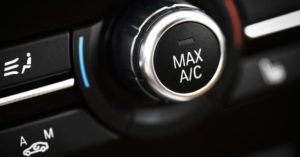Clean the front of the condenser: The debris that builds up between the fins can really raise the head pressures, and that not only affects performance but can cause slipping of a clutch if voltage is marginal. If a vehicle is an underbody breather, raise it on a lift and look underneath. If there’s through-the-grille breathing, look between the grille bars with a flashlight. Note that you may have to remove the grille for access. If there’s a gap between the condenser and radiator, it may have a road-film buildup between the parts, and washing that out can be very helpful.
See if both service valve caps are installed: They’re the primary seals and an SAE standard specifies that the caps be tethered to the service valve. In the meantime, everything out there doesn’t have the tethers, so look and replace. If it’s a vehicle with airflow seals, make sure they’re not missing, and that the shroud is secured
On vehicles with clutch fans, give the fan a hard spin by hand when it’s cold; it should spin no more than three times. If it stops in a single turn or less, it may be partly locked up, which will slow engine warmup. If it spins very easily, perhaps five turns, the clutch may be worn or leaking. Examine and feel the seal area for silicone fluid (black stuff).
Check the electric fan(s) operation (even if there’s a clutch fan, there also may be an electric). Test the blend-air or temperature door operation. Make sure the heater coolant valve and outside air flap door are closed in Max A/C
Check idle speed stability: If you’re doing tune-up work, such as plugs, wires, air filter, exhaust gas recirculation valve, etc., this will be routine. If the hot idle remains rough, the cause often is a throttle body contaminated with dirt that got past the air cleaner, deposits from the crankcase ventilation and exhaust systems. The powertrain computer often shuts down the A/C when idle is rough. With the engine idling, turn on the A/C and see if the clutch engages smartly. If it doesn’t, check the voltage to the clutch. If it’s marginal, say at or under 11 volts, the clutch may slip in really hot weather. You may find a loose or corroded connection or two.
Do an A/C performance test. The correct procedures vary all over the lot, so if you plan to use the vehicle maker’s specifications, follow the procedure to the letter. Sure, the pressure gauges should be connected, the system should be in ‘recirc’ … and that’s about all that’s across-the-board.

